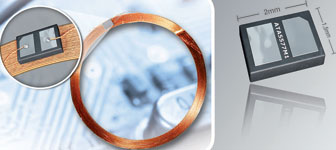

Atmel announced the availability of an ultra-small XDFN (extremely thin dual flat no leads) package including a 363-bit read/write transponder IDIC. The ATA5577M1 is a high-volume, low-frequency (LF, 100–150 kHz) RFID (radio frequency identification) device designed for small tag applications including animal ID ear and bolus tags, standard key fobs or clamshell cards for access control solutions.
The two coil wires can be directly soldered onto the two pads of the package and mounted or glued onto the antenna coil. The direct mounting and small packaging allows for extremely small end products since the resulting RFID tag size is basically determined by the size of the coil.
The 2 x 1,5 x 0,37 mm package can also be soldered on a standard printed circuit board (PCB), for example, in combination with a PCB-mounted antenna. Since the chip has a 330 pF on-chip capacitor trimmed to ±3%, the antenna coil is the only external component required to form a trimmed LF-RFID tag.
With the XDFN package, handling the chip is not necessary and, as a result, the requirements for the environmental conditions during production are less stringent. Packing of the chip using PCB boards or micromodules is also unnecessary, thus reducing production steps. The package can be mounted or glued directly on the coil for smaller end products.
The incorporated ATA5577 chip provides a manufacturer-programmed and locked unique ID which enables the traceability of the product to prevent cloning or counterfeiting of the tag IC. The unique ID and the extended read/write distances have been optimised for next-generation access control applications including hotel rooms, engineering departments, offices, time recording systems, parking lots, customer loyalty and membership cards.
A special on-chip digital register allows the maximum overall read and write distance for each application environment. Based on the dedicated write procedure (downlink, reader-to-tag), the write distance has been increased to industry-leading distances. This increased write distance is especially beneficial for applications in difficult environments.
In addition, the device operates according to ISO 11784 and ISO 11785 (FDX-B) standards, making it well suited for animal identification and waste management applications.
Since the ATA5577 is a low-frequency device, it can be used worldwide. It is not sensitive to rugged environments and can also be used under conditions that normally complicate the application of RFID devices, for example, water, metal, dirt, or being applied on the body.
For more information contact EBV Electrolink, +27 (0)21 402 1940, [email protected], www.ebv.com
| Tel: | +27 11 236 1900 |
| Email: | [email protected] |
| www: | www.ebv.com |
| Articles: | More information and articles about EBV Electrolink |

© Technews Publishing (Pty) Ltd | All Rights Reserved